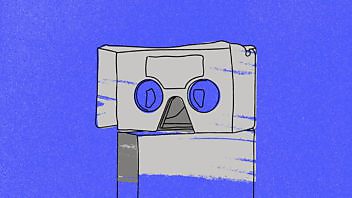I love this story so much.
It’s 2014 and virtual reality is the next ‘next big thing’. Everyone is aiming to get into it. All the FAANGs are out.
And these two French engineers at Google, David Coz and Damien Henry, have this idea (during their “innovation time off” that Google gives its people).
The idea is to get as many VR headsets into users’ hands so they can get out there early and learn about content and users and stuff like that.
And the solution?
Cardboard.
A foldable cardboard viewer with two lenses, a magnet, tape and some velcro.
And they wouldn’t even make the product: they’d give the plans away to anyone who wanted to make it. (Wikipedia says, “Pre-manufactured viewers were only available from third-party vendors until February 2016 when Google released its own.”).
With the kit, users could assemble the viewer, slip their own smartphone into it, and open up a VR experience to view.
Wikipedia: “Through March 2017, over 10 million Cardboard viewers had shipped and over 160 million Cardboard app downloads had been made.”
10 million viewers.
160 million downloads.
For something made of… cardboard!?!
The lowest-tech material on the planet except maybe burlap.
Or rocks.
One of the biggest, most innovative tech companies in the world. Creator and leader of enormous markets.
And they release something made of cardboard?
I love this story so much.
This is Minimum Viability at its most exquisite.
And here’s what it did for Google:
- Got them into an important emerging market, fast.
- Got millions of users involved – most of whom weren’t yet ready to invest in any VR hardware.
- With something that delivered 90% of the then-benchmark VR experience. At extremely low cost to Google (Because it was built around something every user already owned: a smartphone). (And, um, because it was made of card-frickin-board).
- Gave them lots and lots of first-hand experience with users and content —generating lots of data from all those experiences.
- Got thousands of developers playing with their version of VR (it was launched with an SDK). In the first 19 months, 1,000 apps were published.
- Accelerated Google’s own VR innovations – like Daydream, VR View, Jump, and Expeditions.
- Got brands like Volvo and LG and Coachella and The New York Times to make branded versions and associated VR experiences.
All of that is impressive AF. But even more impressive is what Google Cardboard signaled to the world. (The exact things I hope marketers will steal):
It signaled confidence. The confidence to go low-tech in the middle of a high-tech, winner-takes-most arms race.
It signaled playfulness. (Did I mention it was made of cardboard?). And playfulness is such an attractive quality in a brand.
It signaled the joy of experimentation. And the even greater joy of letting an experiment succeed even when it’s patently, stone-cold crazy.
It signaled openness and generosity. By releasing the plans to the world for free.
It also worked to lower users’ expectations so that the experiences themselves would dramatically exceed those expectations. (I got one and was kind of blown away by how far VR had already come).
So how can we marketers steal from this? We can do it by:
• Giving our people time to think and play and innovate.
• Being open-minded enough to fan the flames of their early ideas instead of peeing those flames out.
• Getting our ideas to market faster. Earlier. Recognizing that your customers will understand what you’re doing and adjust their expectations accordingly. M.V.P.
• Inviting others into our playgrounds – developers, other brands… even competitors.
• Being confident. Confident enough to to do all of the above in public.
Marketers of the world: break out the cardboard.
More from the Let’s Steal From series
The Beatles – or should we say the B2Beatles…
Holiday movies – Yeah, those. Polarizing but lesson-packed.
The Simpsons – The most successful TV show of all time has lots to teach.
17th Century Explorers – And you thought marketers had a rough time convincing their audience.
The NBA – It was just basketball, then it took over the world.
Iceland air – How emphasising experience can make the middle of nowhere the destination.
The New York Times – You could do worse than stealing from the very best.
The MarTech Supergraphic – You too can build your own content powerhouse. Maybe.
The Democratic Mid-Term campaigns – Whatever you think about her politics, Alexandra Ocasio-Cortez sure is doing marketing right.
Follow The Frog – Making people feel bad is not the only way to raise money for charity.
Paths of Flight – Soothing plane videos from GE Aviation.
The Greatest Infographic Ever – From 1869. See it and weep.
Epic Split – Jean-Claude van Damme teams up with Volvo Trucks and they both come out of it very well.
Great First Lines of Novels – Incisive content from the likes of Orwell, Salinger and Garcia Marquez.
Rand Fishkin and Moz’s Whiteboard Fridays – Only one of the most successful and longest-running B2B content franchises ever made.
Airbnb City Guides – Crowdsourcing your way to content greatness.
TED Talks – SO much to steal here…

Enjoyed this article?
Take part in the discussion








Comments
Sam Smythe February 24th, 2020
Haha!! This was so much fun to read 😃 I guess we could steal a little bit of confidence from the giant 😁 that’s the most important thing of all.
Doug Kessler March 2nd, 2020
Thanks, Sam. It’s funny to say, “Be like Google” — but I love that such a giant could come out with such a playful move!